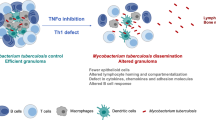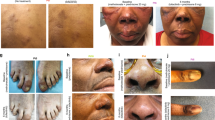Abstract
This Review focuses on the emergence of mycobacterial disease in patients undergoing treatment for rheumatic disease with four new drug classes—tumor necrosis factor (TNF) inhibitors, human interleukin (IL)-1 receptor antagonists, anti-CD20 antibodies and CD4+ T-cell costimulation modulators—collectively referred to as biologic agents. Mycobacterial disease is a major cause of severe infection in patients undergoing anti-TNF therapy. Reports are now emerging of an association between mycobacterial infection and antirheumatic treatment with anti-IL-1 or anti-CD20 antibodies. Although tuberculosis is the most common mycobacterial disease, nontuberculous mycobacterial (NTM) disease is an increasingly recognized problem in this setting. Among the antirheumatic drugs currently in development, agents that target IL-17, IL-23, Janus kinase–signal transducers and activators of transcription signaling, and metalloproteinases are likely to confer an increased risk of mycobacterial disease. Although screening and preventive treatments have lowered the incidence of active tuberculosis, these tools are not applicable to patients with NTM disease. All patients receiving drugs associated with an increased risk of mycobacterial disease should be carefully monitored, and suspect lesions should undergo Mycobacterium culture. Further studies are needed to determine the prevalence of NTM disease in this setting, and to evaluate the safety of simultaneous anti-TNF and antimycobacterial treatment.
This is a preview of subscription content, access via your institution
Access options
Subscribe to this journal
Receive 12 print issues and online access
$209.00 per year
only $17.42 per issue
Buy this article
- Purchase on Springer Link
- Instant access to full article PDF
Prices may be subject to local taxes which are calculated during checkout


Similar content being viewed by others
References
Winthrop KL (2006) Serious infections with antirheumatic therapy: are biologicals worse. Ann Rheum Dis 65 (Suppl 3): 54–57
Griffith DE et al. (2007) An official ATS/IDSA statement: diagnosis, treatment, and prevention of nontuberculous mycobacterial diseases. Am J Respir Crit Care Med 175: 367–416
Salvana EM et al. (2007) Mycobacterium other than tuberculosis (MOTT) infection: an emerging disease in infliximab-treated patients. J Infect 55: 484–487
Winthrop KL et al. (2008) Mycobacterial and other serious infections in patients receiving anti-tumor necrosis factor and other newly approved biologic therapies: case finding through the Emerging Infections Network. Clin Infect Dis 46: 1738–1740
Gardam MA et al. (2003) Anti-tumour necrosis factor agents and tuberculosis risk: mechanisms of action and clinical management. Lancet Infect Dis 3: 148–155
Roach DR et al. (2002) TNF regulates chemokine induction essential for cell recruitment, granuloma formation, and clearance of mycobacterial infection. J Immunol 168: 4620–4627
Saliu OY et al. (2006) Tumor-necrosis-factor blockers: differential effects on mycobacterial immunity. J Infect Dis 194: 486–492
Salliot C et al. (2008) Risk of serious infections during rituximab, abatacept and anakinra therapies for rheumatoid arthritis: meta-analyses of randomized placebo-controlled trials. Ann Rheum Dis [doi:10.1136/ard.2007.083188]
Fleischmann RM et al. (2006) Safety of extended treatment with anakinra in patients with rheumatoid arthritis. Ann Rheum Dis 65: 1006–1012
Brassard P et al. (2006) Antirheumatic drugs and the risk of tuberculosis. Clin Infect Dis 43: 717–722
Settas LD et al. (2007) Reactivation of pulmonary tuberculosis in a patient with rheumatoid arthritis during treatment with IL-1 receptor antagonists (anakinra). J Clin Rheumatol 13: 219–220
Weinblatt M et al. (2006) Safety of the selective costimulation modulator abatacept in rheumatoid arthritis patients receiving background biologic and nonbiologic disease-modifying antirheumatic drugs: a one-year randomized, placebo-controlled study. Arthritis Rheum 54: 2807–2816
Bigbee CL et al. (2007) Abatacept treatment does not exacerbate chronic Mycobacterium tuberculosis infection in mice. Arthritis Rheum 56: 2557–2565
Riley P et al. (2008) Effectiveness of infliximab in the treatment of refractory juvenile dermatomyositis with calcinosis. Rheumatology (Oxford) 47: 877–880
Gottlieb AB et al. (2004) Infliximab induction therapy for patients with severe plaque-type psoriasis: a randomized, double-blind, placebo-controlled trial. J Am Acad Dermatol 51: 534–542
Baughman RP et al. (2006) Infliximab therapy in patients with chronic sarcoidosis and pulmonary involvement. Am J Respir Crit Care Med 174: 795–802
Naganuma M et al. (2008) Efficacy of infliximab for induction and maintenance of remission in intestinal Behçet's disease. Inflamm Bowel Dis 14: 1259–1264
The Lenercept Multiple Sclerosis study group and the University of British Columbia MS/MRI analysis group (1999) TNF neutralization in MS: results of a randomized, placebo-controlled multicenter study. Neurology 53: 457–465
Rennard SI et al. (2007) The safety and efficacy of infliximab in moderate to severe chronic obstructive pulmonary disease. Am J Respir Crit Care Med 175: 926–934
Kay J et al. (2008) Golimumab in patients with active rheumatoid arthritis despite treatment with methotrexate: a randomized, double-blind, placebo-controlled, dose-ranging study. Arthritis Rheum 58: 964–975
Schreiber S et al. (2007) Maintenance therapy with certolizumab pegol for Crohn's disease. N Engl J Med 357: 239–250
Smolen JS et al. (2008) Effect of interleukin-6 receptor inhibition with tocilizumab in patients with rheumatoid arthritis (OPTION study): a double-blind, placebo-controlled, randomised trial. Lancet 371: 987–997
Saunders BM et al. (2000) Interleukin-6 induces early gamma interferon production in the infected lung but is not required for generation of specific immunity to Mycobacterium tuberculosis infection. Infect Immun 68: 3322–3326
Nagabhushanam V et al. (2003) Innate inhibition of adaptive immunity: Mycobacterium tuberculosis-induced IL-6 inhibits macrophage responses to IFN-gamma. J Immunol 171: 4750–4757
Lubberts E (2008) IL-17/Th17 targeting: on the road to prevent chronic destructive arthritis. Cytokine 41: 84–91
McInnes IB et al. (2005) Cytokine networks—towards new therapies for rheumatoid arthritis. Nat Clin Pract Rheumatol 1: 31–39
Khader SA and Cooper AM (2008) IL-23 and IL-17 in tuberculosis. Cytokine 41: 79–83
Malemud CJ and Miller AH (2008) Pro-inflammatory cytokine-induced SAPK/MAPK and JAK/STAT in rheumatoid arthritis and the new anti-depression drugs. Expert Opin Ther Targets 12: 171–183
Haverkamp MH et al. (2006) Human host genetic factors in nontuberculous mycobacterial infection: lessons from single gene disorders affecting innate and adaptive immunity and lessons from molecular defects in interferon-gamma-dependent signaling. Microbes Infect 8: 1157–1166
Murphy G and Nagase H (2008) Reappraising metalloproteinases in rheumatoid arthritis and osteoarthritis: destruction or repair. Nat Clin Pract Rheumatol 4: 128–135
Taylor JL et al. (2006) Role for matrix metalloproteinase 9 in granuloma formation during pulmonary Mycobacterium tuberculosis infection. Infect Immun 74: 6135–6144
Keane J et al. (2001) Tuberculosis associated with infliximab, a tumor necrosis factor α neutralizing agent. N Engl J Med 345: 1098–1104
Gómez-Reino JJ et al. (2003) Treatment of rheumatoid arthritis with tumor necrosis factor inhibitors may predispose to significant increase in tuberculosis risk: a multicenter active-surveillance report. Arthritis Rheum 48: 2122–2127
Wallis RS et al. (2004) Granulomatous infectious diseases associated with tumor necrosis factor antagonists. Clin Infect Dis 38: 1261–1265
Maimon N et al. (2007) Fatal pulmonary Mycobacterium xenopi in a patient with rheumatoid arthritis receiving etanercept. Thorax 62: 739–740
Yim K et al. (2004) Recurrent Mycobacterium xenopi infection in a patient with rheumatoid arthritis receiving etanercept. Scand J Infect Dis 36: 150–154
Chopra N et al. (2002) Mycobacterium marinum tenosynovitis in a patient on etanercept therapy for rheumatoid arthritis. J Clin Rheumatol 8: 265–268
Thomas JE et al. (2006) Fatal pulmonary Mycobacterium abscessus infection in a patient using etanercept. Hawaii Med J 65: 12–15
van Ingen J et al. (2007) Pulmonary Mycobacterium szulgai infection and treatment in a patient receiving anti-tumor necrosis factor therapy. Nat Clin Pract Rheum 3: 414–419
van Ingen J et al. (2008) Clinical relevance of Mycobacterium xenopi isolation and its determinants in the Netherlands. Emerg Infect Dis 14: 385–389
van Ingen J et al. (2008) Clinical relevance of Mycobacterium szulgai in the Netherlands. Clin Infect Dis 46: 1200–1205
Winthrop KL et al. (2007) Nontuberculous mycobacterial disease: updated diagnostic criteria for an under-recognized infectious complication of anti-tumor necrosis factor therapy. Nat Clin Pract Rheumatol 3: E1
Bala S et al. (1998) Inhibition of tumor necrosis factor alpha alters resistance to Mycobacterium avium complex infection in mice. Antimicrob Agents Chemother 42: 2336–2341
Centers for Disease Control and Prevention (2004) Tuberculosis associated with blocking agents against tumor necrosis factor-alpha—California, 2002–2003. MMWR Morb Mortal Wkly Rep 53: 683–686
British Thoracic Society (BTS) Standards of Care Committee (2005) BTS recommendations for assessing risk and for managing Mycobacterium tuberculosis infection and disease in patients due to start anti-TNF-alpha treatment. Thorax 60: 800–805
Pai M et al. (2004) Interferon-gamma assays in the immunodiagnosis of tuberculosis: a systematic review. Lancet Infect Dis 4: 761–776
Sellam J et al. (2007) Comparison of in vitro-specific blood tests with tuberculin skin test for diagnosis of latent tuberculosis before anti-TNF therapy. Ann Rheum Dis 66: 1610–1615
Matulis G et al. (2008) Detection of latent tuberculosis in immunosuppressed patients with autoimmune diseases: performance of a Mycobacterium tuberculosis antigen-specific interferon gamma assay. Ann Rheum Dis 67: 84–90
Sorensen AL et al. (1995) Purification and characterization of a low-molecular-mass T-cell antigen secreted by Mycobacterium tuberculosis. Infect Immun 63: 1710–1717
Sichletidis L et al. (2006) Tuberculosis in patients receiving anti-TNF agents despite chemoprophylaxis. Int J Tuberc Lung Dis 10: 1127–1132
Karakousis PC et al. (2008) Altered expression of isoniazid-regulated genes in drug-treated dormant Mycobacterium tuberculosis. J Antimicrob Chemother 61: 323–331
Research Committee of the British Thoracic Society (2008) Clarithromycin vs ciprofloxacin as adjuncts to rifampicin and ethambutol in the treatment of opportunist mycobacterial pulmonary diseases and an assessment of the value of immunotherapy with M. vaccae: a pragmatic, randomised trial by The British Thoracic Society. Thorax 63: 627–634
Garcia Vidal C et al. (2005) Paradoxical response to antituberculous therapy in infliximab-treated patients with disseminated tuberculosis. Clin Infect Dis 40: 756–759
Wallis RS (2005) Reconsidering adjuvant immunotherapy for tuberculosis. Clin Infect Dis 41: 201–208
Aslanidis S et al. (2008) Is it safe to readminister tumor necrosis factor antagonists following tuberculosis flare. Arthritis Rheum 58: 327–328
Matsumoto T et al. (2006) Infliximab for rheumatoid arthritis in a patient with tuberculosis. N Engl J Med 355: 740–741
Saag KG et al. (2008) American College of Rheumatology 2008 recommendations for the use of nonbiologic and biologic disease-modifying antirheumatic drugs in rheumatoid arthritis. Arthritis Rheum 59: 762–784
Author information
Authors and Affiliations
Corresponding author
Ethics declarations
Competing interests
The authors declare no competing financial interests.
Supplementary information
Rights and permissions
About this article
Cite this article
van Ingen, J., Boeree, M., Dekhuijzen, P. et al. Mycobacterial disease in patients with rheumatic disease. Nat Rev Rheumatol 4, 649–656 (2008). https://doi.org/10.1038/ncprheum0949
Received:
Accepted:
Issue Date:
DOI: https://doi.org/10.1038/ncprheum0949
This article is cited by
-
Zwei schwere Fälle von disseminiert-kutanen, nichttuberkulösen Mykobakteriosen durch Mycobacterium haemophilum
Zeitschrift für Rheumatologie (2023)
-
Successful resumption of tocilizumab for rheumatoid arthritis after resection of a pulmonary Mycobacterium avium complex lesion: a case report
BMC Pulmonary Medicine (2015)
-
Mycobacterial Infections in Patients Treated with Tumor Necrosis Factor Antagonists in South Korea
Lung (2013)
-
Is continuation of anti-tumor necrosis factor-α therapy a safe option for patients who have developed pulmonary mycobacterial infection?
Clinical Rheumatology (2012)
-
Nontuberculous mycobacteria infection in solid organ transplant recipients
European Journal of Clinical Microbiology & Infectious Diseases (2012)



